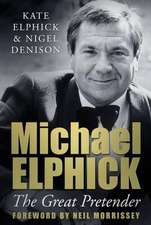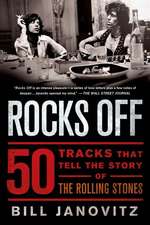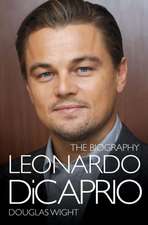Who the Hell's in It: Conversations with Hollywood's Legendary Actors
Autor Peter Bogdanovichen Limba Engleză Paperback – 30 sep 2005
Now, in his new book, Who the Hell’s in It, Bogdanovich draws upon a lifetime of experience, observation and understanding of the art to write about the actors he came to know along the way; actors he admired from afar; actors he worked with, directed, befriended. Among them: Lauren Bacall, Humphrey Bogart, James Cagney, John Cassavetes, Charlie Chaplin, Montgomery Clift, Marlene Dietrich, Henry Fonda, Ben Gazzara, Audrey Hepburn, Boris Karloff, Dean Martin, Marilyn Monroe, River Phoenix, Sidney Poitier, Frank Sinatra, and James Stewart.
Bogdanovich captures—in their words and his—their work, their individual styles, what made them who they were, what gave them their appeal and why they’ve continued to be America’s iconic actors.
On Lillian Gish: “the first virgin hearth goddess of the screen . . . a valiant and courageous symbol of fortitude and love through all distress.”
On Marlon Brando: “He challenged himself never to be the same from picture to picture, refusing to become the kind of film star the studio system had invented and thrived upon—the recognizable human commodity each new film was built around . . . The funny thing is that Brando’s charismatic screen persona was vividly apparent despite the multiplicity of his guises . . . Brando always remains recognizable, a star-actor in spite of himself. ”
Jerry Lewis to Bogdanovich on the first laugh Lewis ever got onstage: “I was five years old. My mom and dad had a tux made—I worked in the borscht circuit with them—and I came out and I sang, ‘Brother, Can You Spare a Dime?’ the big hit at the time . . . It was 1931, and I stopped the show—naturally—a five-year-old in a tuxedo is not going to stop the show? And I took a bow and my foot slipped and hit one of the floodlights and it exploded and the smoke and the sound scared me so I started to cry. The audience laughed—they were hysterical . . . So I knew I had to get the rest of my laughs the rest of my life, breaking, sitting, falling, spinning.”
John Wayne to Bogdanovich, on the early years of Wayne’s career when he was working as a prop man: “Well, I’ve naturally studied John Ford professionally as well as loving the man. Ever since the first time I walked down his set as a goose-herder in 1927. They needed somebody from the prop department to keep the geese from getting under a fake hill they had for Mother Machree at Fox. I’d been hired because Tom Mix wanted a box seat for the USC football games, and so they promised jobs to Don Williams and myself and a couple of the players. They buried us over in the properties department, and Mr. Ford’s need for a goose-herder just seemed to fit my pistol.”
These twenty-six portraits and conversations are unsurpassed in their evocation of a certain kind of great movie star that has vanished. Bogdanovich’s book is a celebration and a farewell.
From the Hardcover edition.
Preț: 146.81 lei
Nou
Puncte Express: 220
Preț estimativ în valută:
28.09€ • 29.33$ • 23.25£
28.09€ • 29.33$ • 23.25£
Carte disponibilă
Livrare economică 14-28 martie
Preluare comenzi: 021 569.72.76
Specificații
ISBN-13: 9780345480026
ISBN-10: 0345480023
Pagini: 528
Ilustrații: HT'S THROUGHOUT
Dimensiuni: 158 x 233 x 29 mm
Greutate: 0.56 kg
Editura: BALLANTINE BOOKS
ISBN-10: 0345480023
Pagini: 528
Ilustrații: HT'S THROUGHOUT
Dimensiuni: 158 x 233 x 29 mm
Greutate: 0.56 kg
Editura: BALLANTINE BOOKS
Recenzii
“[Peter Bogdanovich] knows practically everything about the movies…this book is among the richest (and most delightful) ever written about Hollywood. Deeply elegiac.”
–Ben Schwarz, Atlantic Monthly
“An invaluable archive of a nearly lost cinematic world that director-actor Bogdanovich has himself intimately inhabited for some 50 years.”
–Alan Moores, Booklist
“[Bogdanovich] treats his subjects with sympathy throughout. What comes through is Bogdanovich’s abiding love of cinema…”
–Library Journal
“Those who like classic movies will fall in love with this book…[and] find themselves wishing for more.”
–Publisher’s Weekly
“Just as he did with Who the Devil Made It?, Peter Bogdanovich is keeping history alive with Who the Hell’s In It? He was there at the crossroads, between the Old and New Hollywoods, as an actor, then as a repertory programmer, a critic, a director, and a confidante. And always as a fan, whose love for movies has only increased over the years. There are so many wonderful memories contained in these pages, so many lovingly rendered details, so many engrossing stories. And somehow, all of the actors and actresses here, from Brando to Clift, from John Wayne to John Cassavetes, seem at once human and larger than life. Who the Hell’s In It? is indispensable.”
–Martin Scorsese
“What a treat this book is. Funny, intimate, thoughtful, surprising. And one helluva read. The conversations and opinions contained here are as informative as they are refreshing . . . These are the true legends who earned the title legitimately. With this book, their alchemy is preserved for posterity.”
–Rex Reed
“A completely unique, moving book full of Bogdanovich’s well-known expertise and limitless affection for anyone and anything to do with good movies.”
–Wes Anderson
“A wonderful book, both personal and partisan, by a true enthusiast and an insider, who is not only one of the great chroniclers of the movies but one of its most gifted practitioners.”
–Paul Theroux
“Peter Bogdanovich has elicited the humanity and personality behind the Personality that became the essential building block of stardom. Why was Marion Morrison John Wayne? The book gives us many insights–but never on the level of gossip or psychiatry. And to hear actors such as these, legends and monuments most of them, discuss their craft, their workmanship, very simply their job–you never see that.”
–David Chase
“ If you love movies, I bet you’ll love this book.”
–Jeff Bridges
From the Hardcover edition.
–Ben Schwarz, Atlantic Monthly
“An invaluable archive of a nearly lost cinematic world that director-actor Bogdanovich has himself intimately inhabited for some 50 years.”
–Alan Moores, Booklist
“[Bogdanovich] treats his subjects with sympathy throughout. What comes through is Bogdanovich’s abiding love of cinema…”
–Library Journal
“Those who like classic movies will fall in love with this book…[and] find themselves wishing for more.”
–Publisher’s Weekly
“Just as he did with Who the Devil Made It?, Peter Bogdanovich is keeping history alive with Who the Hell’s In It? He was there at the crossroads, between the Old and New Hollywoods, as an actor, then as a repertory programmer, a critic, a director, and a confidante. And always as a fan, whose love for movies has only increased over the years. There are so many wonderful memories contained in these pages, so many lovingly rendered details, so many engrossing stories. And somehow, all of the actors and actresses here, from Brando to Clift, from John Wayne to John Cassavetes, seem at once human and larger than life. Who the Hell’s In It? is indispensable.”
–Martin Scorsese
“What a treat this book is. Funny, intimate, thoughtful, surprising. And one helluva read. The conversations and opinions contained here are as informative as they are refreshing . . . These are the true legends who earned the title legitimately. With this book, their alchemy is preserved for posterity.”
–Rex Reed
“A completely unique, moving book full of Bogdanovich’s well-known expertise and limitless affection for anyone and anything to do with good movies.”
–Wes Anderson
“A wonderful book, both personal and partisan, by a true enthusiast and an insider, who is not only one of the great chroniclers of the movies but one of its most gifted practitioners.”
–Paul Theroux
“Peter Bogdanovich has elicited the humanity and personality behind the Personality that became the essential building block of stardom. Why was Marion Morrison John Wayne? The book gives us many insights–but never on the level of gossip or psychiatry. And to hear actors such as these, legends and monuments most of them, discuss their craft, their workmanship, very simply their job–you never see that.”
–David Chase
“ If you love movies, I bet you’ll love this book.”
–Jeff Bridges
From the Hardcover edition.
Notă biografică
Peter Bogdanovich, is the author of thirteen books, including Who the Devil Made It, as well as This Is Orson Welles, The Cinema of Howard Hawks and John Ford. Bogdanovich has directed such plays as The Big Knife, Camino Real and Once in a Lifetime. His films include Targets, The Last Picture Show, What's Up, Doc?, Paper Moon and They All Laughed. His essays and reviews have appeared in the New York Times, Los Angeles Times, Esquire and the New York Observer.
From the Hardcover edition.
From the Hardcover edition.
Extras
MARLON BRANDO
The first and only star I ever asked for an autograph was Marlon Brando; he was also the first star I had met. It was around New Year’s 1954, I was fourteen, and had just seen a matinee at New York’s City Center starring
José Ferrer in a heavy drama, The Shrike. Outside on the darkening winter sidewalk, I was looking at the posters proclaiming the production “a major cultural event” when I glanced up the street toward Seventh Avenue, and instantly from about a half-block away recognized the person coming toward me. My heart started beating faster as I quickly turned back to the poster. I felt I had to talk to him: it was Marlon Brando, for God’s sake, and if I didn’t get an autograph, no one would believe I had just seen him walking up 55th Street toward Sixth Avenue.
I knew Brando was in town shooting the longshoreman drama On the Waterfront, with Elia Kazan directing (and for which Brando would win his first Best Actor Oscar), but I didn’t know until I saw the film eight months later that he was wearing his costume home: soon-to-be-familiarto-the-world gray checkered jacket, work pants and motorcycle boots. I glanced again; when he was just a few feet away, absorbed in thought, hands shoved into the jacket’s side pockets, I turned and approached him, saying, “Mr. Brando, may I have your autograph?”
He didn’t alter his step a fraction, looked at me briefly, and just kept walking as he said, fairly deadpan, with that slightly nasal Midwestern twang, “Yeah.” I fell in step with him, starting to search for a pad and pencil
I knew I had somewhere, which is what I muttered. Brando looked over at me, still walking, and said, not unpleasantly, “You got a pen?”
I repeated that it was on me someplace and, to fill the moment, said enthusiastically that I had just seen José Ferrer in The Shrike. Had he seen it?
“Yeah,” he said, “I thought it stunk.”
I stammered something meek, finally found the pencil and small pad, handed them over. Still without hesitating or changing his stride, Brando signed his name lengthwise on the pad, first name above the second, then gave it and the pencil back to me. I thanked him and, still a bit thrown by his comment on the Ferrer production, couldn’t really get it together for another remark, mind speeding the whole time to a kind of blurred blank. I would later recognize that same strange look of stasis on people asking for my autograph. The mind goes into overload–there is suddenly so much to talk about that no words at all can formulate themselves.
At this point in his career, Brando was already a kind of legend and yet he had appeared only in two successful Broadway plays (in the original Life with Father and in Kazan’s production of Tennessee Williams’ A Streetcar Named Desire) and five films, of which two (Fred Zinnemann’s The Men, and Laslo Benedek’s The Wild One, both produced by Stanley Kramer) had done poorly at the box office. When I ran into him on the
street, I’d seen four of those five film performances more than once: seen him as Stanley Kowalski in Kazan’s film version of A Streetcar Named Desire (Brando’s first Oscar nomination); in the title role for Kazan’s Viva
Zapata!, written by John Steinbeck; as Marc Antony in the all-star Joseph Mankiewicz—John Houseman production of Shakespeare’s Julius Caesar; and as the rebel biker in The Wild One, the first biker film, essentially the start of the modern Western.
After twelve years, Roger Corman had the first success in this genre with The Wild Angels (for which I wrote 80 percent of the final script and directed the second unit), making Peter Fonda a star and therefore setting
the stage for Easy Rider three years later, which finally made the genre legitimate. And altered the Hollywood hierarchy radically for a while by inaugurating the brief Era of the Director in the United States, of which
Brando himself would become an integral, indeed crucial, element with his 1972 performances in The Godfather and Last Tango in Paris, the wheel coming full circle.
Brando’s first picture, The Men, had not been in circulation since its small initial 1950 release; Brando as a paraplegic was such a dud financially that when it was reissued (not until 1957, to cash in on Brando’s extraordinary popularity in the mid-fifties) the title was changed to Battle Stripe to make it seem like a new war film. The public wasn’t fooled and the movie fared no better. The Wild One (despite the success of Streetcar and moderate winners Zapata and Caesar) had recently opened in New York as the top half of a one-week double-bill, a sure sign that the studio didn’t think it would work commercially.
Meanwhile, Brando is brilliant in both, and was already by this moment in time the hippest actor there was, the most influential, most imitated, most controversial, most respected by other actors. Since I wanted very much to be a professional actor, my awe in his presence essentially rendered me speechless though my mind was racing with all those many images of Brando I had already accumulated. The whole truth is that in those early teenage days I was a popular mimic at school, doing impressions of a number of stars, Brando prominent among them, and to such a degree that within a year or so some students started calling me Marlon.
By now, Brando and I had reached the corner of Sixth Avenue and 55th. The light was green so Brando kept going. I thanked him again as he moved off the curb and glanced at me to say, “So-long, kid.” As he did I
noticed one boot stepped into a pile of dog shit. I thought of advising him of what had happened but he continued on determinedly, hands shoved back into jacket pockets, and I flashed that my father had said stepping in dog shit was good luck. Certainly before I could figure out how to say, “You just stepped in dog shit,” he was at the other side of the avenue, and soon disappearing into the darkness.
For years I treasured the little piece of paper with Brando’s signature on it, carrying it in my wallet long into my twenties (though now it’s lost). That evening, on the bus home, I felt a kind of magical sense of being special,
of being among the chosen; why else would I be lucky enough to have had such an encounter? My inside pocket glowed like hot gold with the proof it contained of the miracle, the benediction. Certainly, I’d never felt anything like this before. Perhaps it’s the sudden proximity to genius, talent or celebrity; the old thing about the spotlight falling on you because you’re momentarily illuminated by the star’s glow: reflected glory. I have felt it many times since that chance meeting with Brando but never again with the kind of intense mystery of the first experience.
From the Hardcover edition.
The first and only star I ever asked for an autograph was Marlon Brando; he was also the first star I had met. It was around New Year’s 1954, I was fourteen, and had just seen a matinee at New York’s City Center starring
José Ferrer in a heavy drama, The Shrike. Outside on the darkening winter sidewalk, I was looking at the posters proclaiming the production “a major cultural event” when I glanced up the street toward Seventh Avenue, and instantly from about a half-block away recognized the person coming toward me. My heart started beating faster as I quickly turned back to the poster. I felt I had to talk to him: it was Marlon Brando, for God’s sake, and if I didn’t get an autograph, no one would believe I had just seen him walking up 55th Street toward Sixth Avenue.
I knew Brando was in town shooting the longshoreman drama On the Waterfront, with Elia Kazan directing (and for which Brando would win his first Best Actor Oscar), but I didn’t know until I saw the film eight months later that he was wearing his costume home: soon-to-be-familiarto-the-world gray checkered jacket, work pants and motorcycle boots. I glanced again; when he was just a few feet away, absorbed in thought, hands shoved into the jacket’s side pockets, I turned and approached him, saying, “Mr. Brando, may I have your autograph?”
He didn’t alter his step a fraction, looked at me briefly, and just kept walking as he said, fairly deadpan, with that slightly nasal Midwestern twang, “Yeah.” I fell in step with him, starting to search for a pad and pencil
I knew I had somewhere, which is what I muttered. Brando looked over at me, still walking, and said, not unpleasantly, “You got a pen?”
I repeated that it was on me someplace and, to fill the moment, said enthusiastically that I had just seen José Ferrer in The Shrike. Had he seen it?
“Yeah,” he said, “I thought it stunk.”
I stammered something meek, finally found the pencil and small pad, handed them over. Still without hesitating or changing his stride, Brando signed his name lengthwise on the pad, first name above the second, then gave it and the pencil back to me. I thanked him and, still a bit thrown by his comment on the Ferrer production, couldn’t really get it together for another remark, mind speeding the whole time to a kind of blurred blank. I would later recognize that same strange look of stasis on people asking for my autograph. The mind goes into overload–there is suddenly so much to talk about that no words at all can formulate themselves.
At this point in his career, Brando was already a kind of legend and yet he had appeared only in two successful Broadway plays (in the original Life with Father and in Kazan’s production of Tennessee Williams’ A Streetcar Named Desire) and five films, of which two (Fred Zinnemann’s The Men, and Laslo Benedek’s The Wild One, both produced by Stanley Kramer) had done poorly at the box office. When I ran into him on the
street, I’d seen four of those five film performances more than once: seen him as Stanley Kowalski in Kazan’s film version of A Streetcar Named Desire (Brando’s first Oscar nomination); in the title role for Kazan’s Viva
Zapata!, written by John Steinbeck; as Marc Antony in the all-star Joseph Mankiewicz—John Houseman production of Shakespeare’s Julius Caesar; and as the rebel biker in The Wild One, the first biker film, essentially the start of the modern Western.
After twelve years, Roger Corman had the first success in this genre with The Wild Angels (for which I wrote 80 percent of the final script and directed the second unit), making Peter Fonda a star and therefore setting
the stage for Easy Rider three years later, which finally made the genre legitimate. And altered the Hollywood hierarchy radically for a while by inaugurating the brief Era of the Director in the United States, of which
Brando himself would become an integral, indeed crucial, element with his 1972 performances in The Godfather and Last Tango in Paris, the wheel coming full circle.
Brando’s first picture, The Men, had not been in circulation since its small initial 1950 release; Brando as a paraplegic was such a dud financially that when it was reissued (not until 1957, to cash in on Brando’s extraordinary popularity in the mid-fifties) the title was changed to Battle Stripe to make it seem like a new war film. The public wasn’t fooled and the movie fared no better. The Wild One (despite the success of Streetcar and moderate winners Zapata and Caesar) had recently opened in New York as the top half of a one-week double-bill, a sure sign that the studio didn’t think it would work commercially.
Meanwhile, Brando is brilliant in both, and was already by this moment in time the hippest actor there was, the most influential, most imitated, most controversial, most respected by other actors. Since I wanted very much to be a professional actor, my awe in his presence essentially rendered me speechless though my mind was racing with all those many images of Brando I had already accumulated. The whole truth is that in those early teenage days I was a popular mimic at school, doing impressions of a number of stars, Brando prominent among them, and to such a degree that within a year or so some students started calling me Marlon.
By now, Brando and I had reached the corner of Sixth Avenue and 55th. The light was green so Brando kept going. I thanked him again as he moved off the curb and glanced at me to say, “So-long, kid.” As he did I
noticed one boot stepped into a pile of dog shit. I thought of advising him of what had happened but he continued on determinedly, hands shoved back into jacket pockets, and I flashed that my father had said stepping in dog shit was good luck. Certainly before I could figure out how to say, “You just stepped in dog shit,” he was at the other side of the avenue, and soon disappearing into the darkness.
For years I treasured the little piece of paper with Brando’s signature on it, carrying it in my wallet long into my twenties (though now it’s lost). That evening, on the bus home, I felt a kind of magical sense of being special,
of being among the chosen; why else would I be lucky enough to have had such an encounter? My inside pocket glowed like hot gold with the proof it contained of the miracle, the benediction. Certainly, I’d never felt anything like this before. Perhaps it’s the sudden proximity to genius, talent or celebrity; the old thing about the spotlight falling on you because you’re momentarily illuminated by the star’s glow: reflected glory. I have felt it many times since that chance meeting with Brando but never again with the kind of intense mystery of the first experience.
From the Hardcover edition.
Descriere
From Lillian Gish to Jack Lemmon, Bogdanovich captures brilliantly--in their own words and in his--the work and styles of 26 fascinating Hollywood iconic actors and actresses. 120 photos in text.












